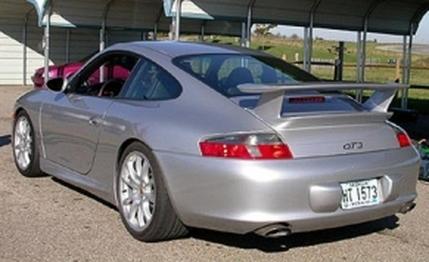
 Mini Test Road Test
Mini Test Road Test
The excitement starts from the moment the engine fires. Only a Porsche, and only a 911, makes these sounds. The rattles and clatter, the idle all uneven and lumpy, the revs jaggedly rising and falling, instantly, explicitly, announce it's a Porsche, and a racing 911 at that.
You need to stand behind the GT3 to best hear, and feel, the quivering mechanical vibrations and resonances. If your hand has been the lucky one to turn the key, then at least lower the window and listen to the sound of the engine. It's obvious, wherever you are, that the cultivated manners of the latest 911 are replaced by tactile sensations born of a pedigree of 16 Le Mans wins and 50 years of club racing. The GT3 wears its heritage on its forehead.
There is a direct link between the legendary 1971 Carrera 2.7 RS and Porsche's new 911 GT3, despite the change from air cooling to water cooling. And it looks as tough as any 911 RS, leaving no one, including the constabulary, in doubt about its mission. The adjustable biplane wing, the front spoiler that is slung so low, and the way the gumball rubber on the 18-inch, 10-spoke wheels fits so snugly below the standard-width wheel arches simply shout purposeful performance.
This is a harder-edged, faster 911, for the hundreds of racing Porsche enthusiasts around the world. They will be happy to hear that their $85,000 GT3 is the fastest road-going car Zuffenhausen has ever built. (Unfortunately, the only U.S. roads it's legal on are surrounded by fences and grand-stands. The bumpers are too low to pass U.S. laws, so like the 964 and 993 RSs, it won't be sold as a street-legal car in America. But if potential buyers show adequate interest, that could change.) With a top speed of 188 mph, the naturally aspirated GT3 is even faster than the previous Turbo and all the many 911 RS models, and that speed translates into sensationally improved lap times. Of course, a new twin-turbo 3.6-liter 911 will be unleashed next year boasting well over 400 horsepower, and it's said to be capable of 194 mph. (Its bumpers will meet U.S.regs.)
But for now, Porsche claims the GT3 is the first production car to break the eight-minute barrier around the 12.9-mile Nürburgring circuit. Walter Röhrl, former world rally champion, piloted the road version through in 7 minutes and 56.33 seconds, almost 40 seconds quicker than he's gone in the garden-variety 911.
The GT3, like so many of its predecessors, is a race car that can be driven on any street. It was developed by Porsche Motorsport as the foundation of a new generation of racing 911 s. Therefore, it has titanium connecting rods that permit 9000-rpm engine speeds-1200 rpm faster than the engine's rev limiter will allow.
Inside, the GT3 strikes exactly the right balance between racing and road. It's all black (apart from some prominent touches of alloy), which gives it a more businesslike appearance than the standard 911's cockpit. Race-style fiberglass bucket seats offer token padding. They only adjust fore and aft, they're mounted low, and they hold you tightly, restricting shoulder and arm movement. The tach's 7600-rpm redline is more evidence of the GT3's racing genes. A Club Sport version-expected to account for about 20 percent of the 1300-to-1400 production run-adds a full roll cage, six-point belts, and fire extinguisher. Air conditioning and a sound system are no-charge options on all GT3s.